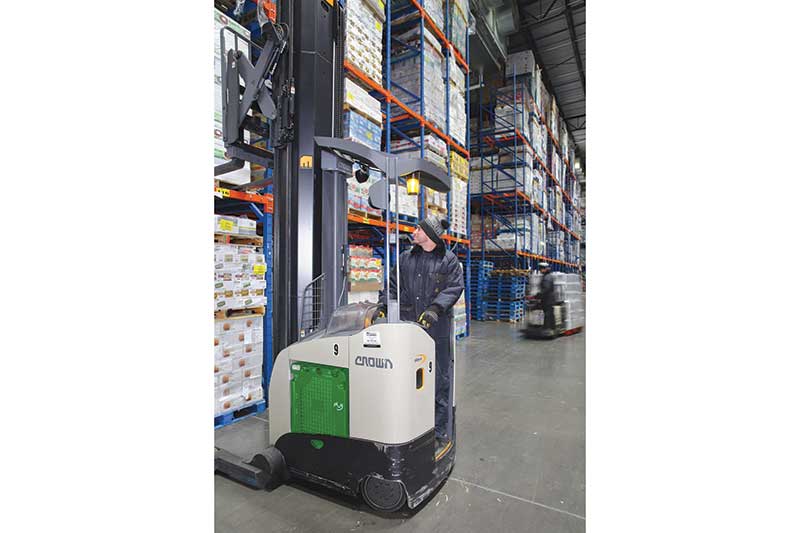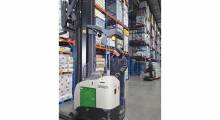Hydrogen fuel cells have always held appeal as the power source for lift truck fleets used in cold storage environments. For one thing, hydrogen fuel cells provide steady and consistent power in below-freezing temperatures. That means no degradation in truck speed or lift performance in between fueling.
That, and rapid refueling (two to three minutes to refuel a cell) to maximize fleet uptime, have been key factors driving increased adoption of hydrogen fuel cells in the cold storage segment.
In June, for example, Plug Power, a provider of hydrogen fuel cell solutions and a global producer of green hydrogen, announced it will supply Blue EnerFreeze, a subsidiary of STEF, a European logistics company that specializes in food products, with a green hydrogen solution across two of its cold storage DCs before potentially expanding further into their network of more than 100 sites.
One of the distribution centers is close to Paris and the other is near Madrid. Toyota is providing STEF with fuel cell-ready electric lift trucks. Fuel cells drop into the electric trucks as the power source.
In recent years, Plug Power has notched some big wins for its GenDrive fuel cells in materials handling, typically for fleets of 100 or even 200 trucks, running multi-shift operations. Some of its major customers include Walmart, Amazon and Home Depot. But an important thing to realize about hydrogen fuel cells as an option for powering electric trucks is that it isn’t limited to the mega-sized fleets running 24/7, says Jose Luis Crespo, Plug Power general manager for materials handling and global key accounts.
Smaller fleets with two shifts looking to maximize the utilization of their trucks have also turned to hydrogen fuel cells, with cold storage DCs in particular being able to justify fuel cells for more modest-sized fleets, says Crespo.
In cold storage, he explains, a fleet of 25 trucks can gain a return on fuel cells because there is no performance fall off between refueling—and the refueling itself only takes a couple of minutes. And, the elimination of battery rooms offers a space savings. While fuel cells do require specialized fuel storage and dispensing infrastructure, the other factors can make the total cost of ownership (TCO) attractive, even if you don’t run a huge fleet.
“With cold storage you have an application where even with a fairly small number of units, you can get a good TCO [from fuel cells],” Crespo says. “In cold storage and freezer applications, you don’t have the performance issues you would with batteries, which would cause a need for more frequent charging or swapping. This means that with fuel cells in cold storage, you’re saving the operation time and improving utilization of the assets, which lowers the TCO.”
At Plug’s annual conference last year, cold storage and logistics company FreezPak Logistics, a Plug customer since 2014, announced it was expanding its use of Plug’s hydrogen infrastructure and fuel cells to an additional nine sites. In moving from batteries to hydrogen, FreezPak saw its electricity bills drop 31.5% and increased usable space by up to 5,000 square feet per location.
In comments at that 2022 conference, FreezPak co-CEO David Saoud explained that not only do the fuel cells ensure truck performance doesn’t get sluggish mid-shift, the space savings are a “huge factor” in why fuel cells make sense for its operations, given that the cost of freezer warehouse space is roughly three times that of a dry warehouse.
Earlier this year, Plug Power unveiled an offering aimed at fleets of less than 100 trucks with a simplified fueling infrastructure, using a smaller gas-based storage system rather than a larger liquid storage system. Plug has transport trucks to move the hydrogen as a liquid and quickly converts it into gas for storage into tanks that hold 300 to 450 kilograms of gas, enough to keep of fleet of 30 to 60 trucks running for a week or more, says Crespo, which is important to ensure operational continuity in case of external events like severe weather.
Plug is also scaling up its production of green hydrogen, with a new plant due to come on line this month in Woodbine, Ga., able to produce 15 tons per day (TPD) of green hydrogen. The company already has other plants in the United States and Europe, with plans to produce 500 metric tons of liquid green hydrogen per day by 2025 in the U.S., and 1,000 metric tons of liquid green hydrogen globally by 2028. Liquid green hydrogen is made by using an electrolysis process and renewable energy sources like wind or solar, rather than a reforming process using natural gas, which traditionally has been how most hydrogen was produced.
Using green hydrogen increases the carbon reduction benefit of fuel cell use, which amplifies the sustainability gains of these systems, says Crespo. Meanwhile, in the U.S. market, a provision in the Inflation Reduction Act called the Production Tax Credit (PTC) helps make hydrogen more cost competitive. The result is that the sustainability reasons of using fuel cells are stronger than ever, Crespo says.
“Traditionally the business case was predicated more on the higher fleet productivity, and the space savings, along with sustainability as a key driver, but now sustainability has become an increasingly important factor,” says Crespo. “It’s a green energy transition companies can make very quickly and start having an immediate impact on their sustainability goals.”
Article topics







